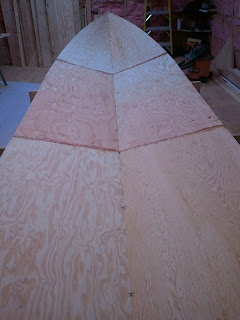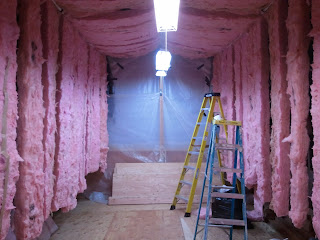Back working on the boat after four days out of town. Took me a few tries to get back in the swing of things. Kept having to go back and forth to get all the right stuff I needed from different areas of the shed.
First I finished screwing the middle jig and horse down, then the rear jig. I wasn't able to do this the other night as I'd broken my two phillips head bits, but a side trip to Home Depot in Anchorage (while there over the weekend) to buy a five pack got me back on track.
Next I grabbed the shelves and changed the angles on the scarfs from 1:1 to 5:1. That increased angle isn't the 8:1 that a really good scarf should be, but it will work just fine for these. I set the right hand shelf on the jig and clamped it to the front and middle jigs and I did the same for the left hand shelf. The front jig uses extensions to drop the clamp point down below the horizontal plane of the main jig and the combination of the two clamps started the bending of the shelves to achieve the upward sweep of the bow. When I checked to see how close the tips of the shelves at the bow were I was pleasantly surprised to find them only about 3/4 of an inch apart. I screwed two blocks to the tips and used a clamp to pull them together.
I grabbed the bowstem (used to tie the tips of the shelves and the tip of the hull together and to provide a place for the sides to connect to when they meet at the bow) and the four framing pieces (two on each side at the rear to provide support and rigidity for the sides between the shelves and the hull) and routed the corners off and then sanded them relatively smooth.
Next up was cutting the end of the 10' long 4x4 that holds the bowstem in place (kinda in midair, you'll see it in the picture), at the right angle (55 degrees) and aligns it with the jig. I attached a piece of 1x4 to the 4x4 and then attached the bowstem to the 1x4. I put the 4x4 on the jig, aligned the tip of the bowstem with the tips of the shelves and TaDa! everything lined up! Yay!
To tie all the pieces together at the bow will require epoxy and a few screws to hold things in place while the epoxy sets. I'll screw the 4x4 to the front and middle jig pieces when I'm ready to lock it in place. There is definitely going to be some work to be done on the bowstem to make everything fit well, but again I'm getting to the point where more custom work will need to be done.
Speaking of which... I worked some on the shelves and corner braces at the rear of the boat. These shelves and corner braces tie the sides to the transom and provide a lot of strength. I grabbed a piece of left over 1 1/8" plywood and started figuring and cutting. Got the first two pieces cut out and went to test fit them and wouldn't you know it, DDD! I'd grabbed a piece of 3/4" ply instead of 1 1/8"! Oh well, templates!
Time to quit, so swept up a good sized pile of sawdust, put the tools away and called it a night.
3.5 Hours

















































